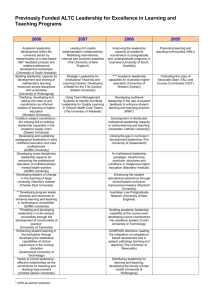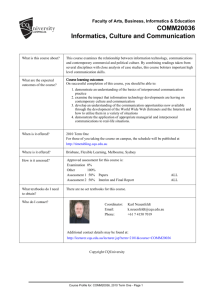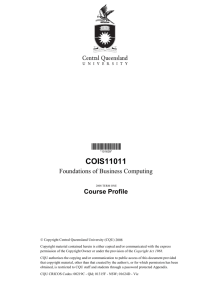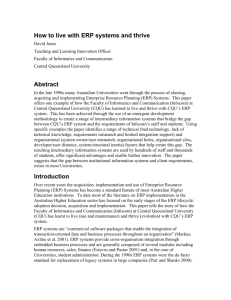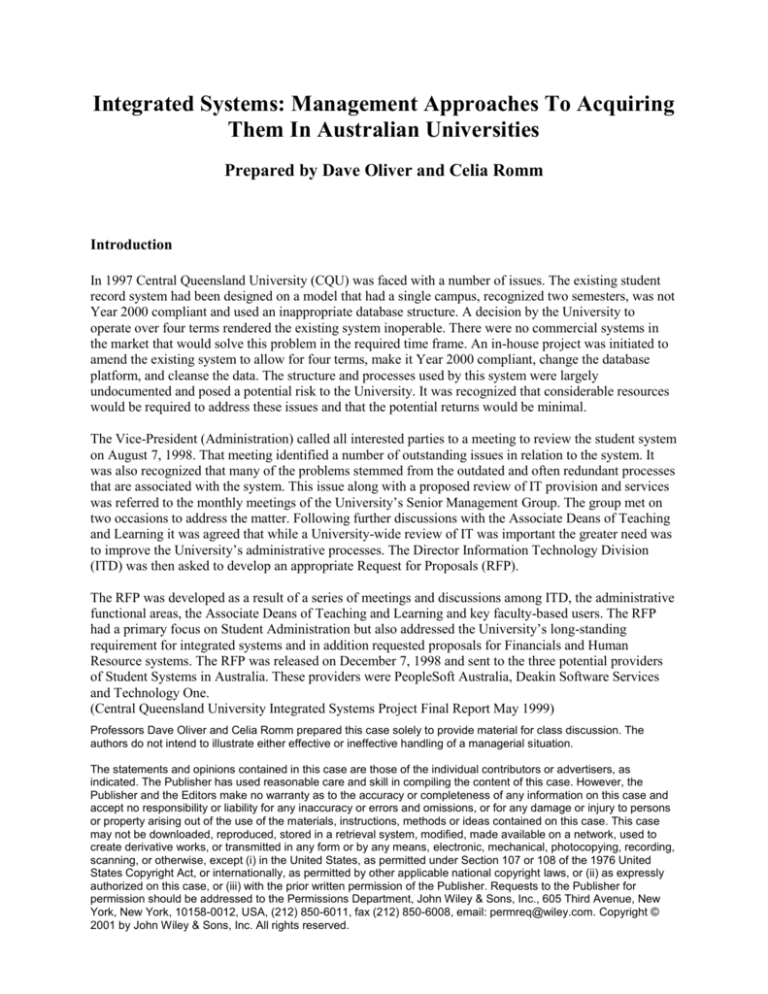
Integrated Systems: Management Approaches To Acquiring
Them In Australian Universities
Prepared by Dave Oliver and Celia Romm
Introduction
In 1997 Central Queensland University (CQU) was faced with a number of issues. The existing student
record system had been designed on a model that had a single campus, recognized two semesters, was not
Year 2000 compliant and used an inappropriate database structure. A decision by the University to
operate over four terms rendered the existing system inoperable. There were no commercial systems in
the market that would solve this problem in the required time frame. An in-house project was initiated to
amend the existing system to allow for four terms, make it Year 2000 compliant, change the database
platform, and cleanse the data. The structure and processes used by this system were largely
undocumented and posed a potential risk to the University. It was recognized that considerable resources
would be required to address these issues and that the potential returns would be minimal.
The Vice-President (Administration) called all interested parties to a meeting to review the student system
on August 7, 1998. That meeting identified a number of outstanding issues in relation to the system. It
was also recognized that many of the problems stemmed from the outdated and often redundant processes
that are associated with the system. This issue along with a proposed review of IT provision and services
was referred to the monthly meetings of the University’s Senior Management Group. The group met on
two occasions to address the matter. Following further discussions with the Associate Deans of Teaching
and Learning it was agreed that while a University-wide review of IT was important the greater need was
to improve the University’s administrative processes. The Director Information Technology Division
(ITD) was then asked to develop an appropriate Request for Proposals (RFP).
The RFP was developed as a result of a series of meetings and discussions among ITD, the administrative
functional areas, the Associate Deans of Teaching and Learning and key faculty-based users. The RFP
had a primary focus on Student Administration but also addressed the University’s long-standing
requirement for integrated systems and in addition requested proposals for Financials and Human
Resource systems. The RFP was released on December 7, 1998 and sent to the three potential providers
of Student Systems in Australia. These providers were PeopleSoft Australia, Deakin Software Services
and Technology One.
(Central Queensland University Integrated Systems Project Final Report May 1999)
Professors Dave Oliver and Celia Romm prepared this case solely to provide material for class discussion. The
authors do not intend to illustrate either effective or ineffective handling of a managerial situation.
The statements and opinions contained in this case are those of the individual contributors or advertisers, as
indicated. The Publisher has used reasonable care and skill in compiling the content of this case. However, the
Publisher and the Editors make no warranty as to the accuracy or completeness of any information on this case and
accept no responsibility or liability for any inaccuracy or errors and omissions, or for any damage or injury to persons
or property arising out of the use of the materials, instructions, methods or ideas contained on this case. This case
may not be downloaded, reproduced, stored in a retrieval system, modified, made available on a network, used to
create derivative works, or transmitted in any form or by any means, electronic, mechanical, photocopying, recording,
scanning, or otherwise, except (i) in the United States, as permitted under Section 107 or 108 of the 1976 United
States Copyright Act, or internationally, as permitted by other applicable national copyright laws, or (ii) as expressly
authorized on this case, or (iii) with the prior written permission of the Publisher. Requests to the Publisher for
permission should be addressed to the Permissions Department, John Wiley & Sons, Inc., 605 Third Avenue, New
York, New York, 10158-0012, USA, (212) 850-6011, fax (212) 850-6008, email: permreq@wiley.com. Copyright ©
2001 by John Wiley & Sons, Inc. All rights reserved.
Institutional progress
In the 1970s Australian Colleges of Advanced Education (CAE) emerged as an alternative to
universities, offering a selection of courses in education, nursing, arts and business that were not
generally offered by universities, or that were parallel to university curricula but with a more
practical emphasis. The professional education market, the requirements of credentialing in
fields like education, as well as the upsurge of interest in continuing education made CAE’s a
popular alternative to universities.
CQU entered the higher education sector as Queensland Institute of Technology (QIT)
Capricornia in 1967 and student enrollment was primarily confined to the local area of about
60,000 people. The campus was located at Rockhampton, situated between the university cities
of Brisbane 650 kilometers to the south and Townsville a similar distance to the north (see
Figure 1). Many students could not afford the cost of residing away from home in Brisbane or
Townsville, while the emerging student group of life-long learners (such as workers, parents
with childcare responsibilities, older people) could not afford to live outside Central Queensland
either (Cryle 1992). In addition there was a perceived need to provide an educational service to
the rich mining area of Central Queensland, specifically to provide technical training in the
engineering and science disciplines that were important for the development of the mining
industry.
QIT at Rockhampton became the Capricornia Institute of Advanced Education (CIAE) in June
1971, initially offering degrees in Applied Science, Business, Engineering and Education, and
later in Arts and Health Science. The geographical context of regional Queensland with its
massive size and small population made distance education an appropriate response to
community needs for higher education. CIAE was the first Australian provider of an external
Bachelor of Applied Science in Physics and Chemistry in 1974 (Cryle 1992). In the following
year Biology and Mathematics were offered externally, as was the Graduate Diploma of
Management. By 1983 external enrolments exceeded internal full-time and part-time enrolments,
becoming a major source of revenue (Cryle 1992). Most external students at this time were
between the ages of 30 and 39.
To increase student enrolment in the mid 1980s and in recognition of changing demands, CQU
decided to provide on site education in the main population centers of the region (initially
Mackay and Gladstone). To some extent this decision was based on demonstrated interest from
the towns themselves. They pushed for the establishment of campuses based on study centers for
distance education students. Initially branch campuses were set up at Mackay and Gladstone
where students could study the first year of a degree, and then move to the Rockhampton campus
to finish the course. In practice some students transferred to other universities after their first
year.
Integrated Systems
Page 2
Figure 1
In part to arrest this process of attrition, in part to exploit the tertiary market that was being
inflated by rising unemployment, in part to mark the university as a truly regional institution, the
second and third years of some degrees were introduced on the other campuses. Also more
campuses at Bundaberg and Emerald (350km to the south and west respectively) were opened.
This resulted in a network of campuses serving a large geographical area of some 616,121 square
kilometers. These new campuses were strongly supported by the local communities who
Integrated Systems
Page 3
contributed funds and/or land that could be developed. Hence Central Queensland University no
longer has a main campus with four branch campuses, but rather has five campuses of equal
status, where students can now study a complete degree, from a growing choice of courses.
A more recent expansion has established sites in Sydney (1994), Melbourne (1996), Brisbane
(1998) and Fiji (1998) through a commercial association with Campus Management Services
(CMS). These campuses represent an extension of the institutional network, as do a number of
overseas centers, mainly in South East Asia. These overseas centers are essentially partnership
arrangements with other educational providers, but extend the networked university concept both
interstate and overseas.
Collaborative Initiative
As a public agency CQU along with other universities (only two of Australia’s 37 universities
are private organizations) is subject to government scrutiny. This means that universities must
provide various statistics to the central government to enable a degree of public monitoring. The
gathering of statistics is a type of information request to which universities would like to be able
to respond expeditiously through the use of IT. The fact that many student record systems were
developed during the 1970s using 3rd generation software technology meant that for many
universities it was a struggle to keep pace with changing requirements for information from the
government. A characteristic of IT systems of this era (i.e. the 1970s) is that they are relatively
inflexible and do not lend themselves easily to changed requirements. Difficulties in meeting
information requests from the government lead universities to consider a cooperative approach to
IT systems development.
The Core Australian Specification for Management and Administrative Computing
(CASMAC) steering committee was formed in 1989 by the Australian Vice-Chancellors’
Committee (AVCC0) and the council of Australia’s university presidents. The AVCC is the peak
organization representing Australian universities nationally and internationally and seeks to
advance higher education through voluntary, cooperative and coordinated action.
CASMAC is intended to meet the following four objectives:
Objective 1:
Specify and maintain the core functional requirements necessary to support the business and
management functions of Australian universities.
Objective 2:
Encourage and provide the basis for cost effective collaborative development and acquisition
of adaptable and integrated core administrative computing applications which will:
1. Meet Australian universities’ core operational and information requirements;
2. Provide the means of complying with statutory responsibilities and managerial obligations in
a timely manner; and
3. Facilitate the effective deployment of university resources.
Integrated Systems
Page 4
Objective 3:
Maximize the ability to respond to external reporting requirements, particularly those of the
government, in a cost effective and timely manner.
Objective 4:
Allow for the flexible adoption and/or exploitation of new and evolving technology and
facilitate the implementation of innovative approaches for management and administrative
systems.
The national Core Australian Specification for Management and Administrative Computing
defines the core functional requirements of the management and administrative needs of
Australian universities for:
Student Systems
Human Resources
Finance Systems
Physical Resources
Research and Consultancy
Executive Reporting
(AVCC 1997)
CASMAC is based on a similar project initiated in 1988 by the University Grants Committee
(UGC) in the United Kingdom that became known as the Management and Administrative
Computing (MAC) initiative. These projects were undertaken because of the difficulties being
experienced by universities in maintaining and redeveloping administrative systems in order to
satisfy increasing demands for information from the government. As the demands for
information came from the government the same demands were placed on all universities. Both
CASMAC and the UK MAC initiative were based on the premise that there was a high degree of
commonality in the core functionality needed to support the administrative and management
functions of universities. The AVCC believed that there were benefits to be obtained by
specifying these requirements and sharing the development and ongoing costs of the resulting
systems.
The Steering Committee was successful in its bid to the central government for funds to
undertake a feasibility study to determine if a similar approach to MAC could be applicable in
Australia. As a result of the feasibility study, it was agreed to proceed with the preparation of
CASMAC. Between April 1991 and July 1991 a small technical specification team together with
consultants from Price Waterhouse used the MAC blueprint as a base for this development. From
December 1991 to May 1992 progressive revisions were made to the specifications. CASMAC
specifications use the structured system specification techniques of data flow diagrams, data
model diagrams and a data dictionary. It has been suggested that the specification may cover
80% of each university’s functional requirements but this is obviously a very rough assessment
of something that cannot really be quantified.
While the term ‘CASMAC’ technically refers to only the core specification it is often used to
include those dimensions of the project that emerged subsequently.
Integrated Systems
Page 5
In July 1992 a Request for Information (RFI) was issued to potential suppliers of systems that
would meet the requirements specified in CASMAC. This RFI required suppliers to indicate how
they might deliver CASMAC-compliant applications to universities and to address a range of
specified issues. Nineteen responses were received. A Request for Tender (RFT) was issued to
the top five potential suppliers after evaluation of the RFI. The responses received were
evaluated against the following criteria: CASMAC compliance, cost, company/consortium
profile, technology platform, time frame and delivery schedule, control/ownership/support and
adaptability and customization capability.
Between January 1993 and March 1993 universities were invited and encouraged to commit to a
collaborative group project based on one of the suppliers responding to the RFT. Such a
commitment would involve:
Agreement to meet a share of the total cost of achieving the CASMAC objective through a
joint venture with that supplier;
Representation on the Management Committee established to oversee the project;
Commitment to the provision of resources in the form of staff time and expertise for systems
development, testing and implementation; and
No commitment for an institution to take any of the applications with timing of
implementation at the discretion of the institutions.
(AVCC 1996)
In April 1993, based on the responses to this invitation, the Steering Committee recommended to
the AVCC that an agreement be signed with two selected suppliers, Oracle and Coulson Heron
Associates (CHA), and that Management Committees for each project be established, reporting
to the CASMAC Steering Committee.
During the following weeks, 19 universities committed to forming a consortium based on the
CHA proposal using the PowerHouse fourth generation development language. This consortium
was subsequently called UniPower.
The UniPower consortium has been the first to announce details of the system it is developing.
On July 27, 1993 it signed a $10.5 million deal with British software house Coulson, Heron and
Associates (CHA) and Canadian-US software house Cognos to begin development of the system
based on the software developed by CHA in the UK. The $10.5 million software cost will be
spread over the 19 universities with contributions being determined by the relative size of each.
(The contribution of CQU was $185,683).
(CASMAC Bulletin #1, 1994)
Integrated Systems
Page 6
Of these 19 universities, 16 were already using Cognos (Powerhouse) products.
For UCQ1 the decision to join the Powerhouse family was easier as there was already a strong
Powerhouse presence with the existing Student Record application being written in the
Powerhouse 4GL language.
(CASMAC Bulletin #1, 1994)
In the same period 11 other universities committed to forming a consortium that would use the
Oracle relational database management system. This consortium was subsequently called the
UniOn Group. Significantly, both successful bidders were also successful in the UK bidding
process and, therefore, had already developed a set of systems that could be used as the basis for
the Australian systems.
Later in 1993, three of the remaining universities agreed on a Memorandum of Understanding
for the joint development, acquisition and exchange of CASMAC compliant software based on
the Natural fourth generation language. These institutions are known as the Natural Group. The
four other universities either determined to develop their own software in-house or to acquire
software from other vendors.
For many IT investment decisions in universities, the question is not ‘should we invest’ but
‘where and how to invest’. It is often not a choice of whether to develop, upgrade, or replace a
system, but which system will efficiently deliver the required benefits, and how should it be
obtained and installed. For such a system, which could be termed an operational or competitive
necessity, ‘return on investment’ is not usually a very relevant measure. Where the system is
fundamental to running the organization and delivering services, there may be no choice but to
invest. In many cases, and especially in the public sector, it is difficult to quantify all of the costs
1
CQU (Central Queensland University) was formerly named UCQ (University of Central Queensland).
Integrated Systems
Page 7
and benefits (Stacey 1993). This may cause some universities to neglect the cost-benefit analysis
of proposed IT projects. Some of these will be operational or competitive necessities, which will
not give you any competitive advantage, but will keep you in the game and thus are necessary for
survival.
Many university administrative IT projects would fall into this category. In attempting to address
the need for such systems, most universities have collaborated in the CASMAC initiative.
Collaborative development has been proposed as a way to share the costs of developing
standardized IT systems for areas such as finance, human resources, student administration and
management information.
The objectives for CASMAC include cost-effective collaborative development and acquisition of
administrative systems to meet the operational and information requirements of the universities,
and especially to enable a standardized response to the universities’ statutory requirements and
external reporting responsibilities to government.
The collaborative focus of CASMAC was therefore intended to provide a framework for
institutional development, towards which universities could migrate in the knowledge that
systems obtained from other universities, or possibly developed in conjunction with other
universities, would have minimum integration problems.
In addition, this separation of the project from individual universities seems to have led to a
distancing from, and lack of ownership by, university line management, even though the
development process involved considerable consultation, and software development teams
usually included application specialists from within the universities. The interviewers often heard
both university IT managers and senior administrators say they were not focused on the
administrative systems of the institution because they were ‘waiting for CASMAC’. It did not
have senior management attention, although some did express concern about how long it was
taking to get UniOn or UniPower systems in place. These delays meant that ‘interim systems’
were sometimes being developed or purchased by some universities to meet the immediate needs
of the institution.
Competition between universities has grown since CASMAC began in 1991, and this is leading
to increasing strategic differentiation. Perhaps this changing strategic focus within universities
has contributed to the lack of attention to and ‘ownership’ of the CASMAC initiative by
individual universities.
(Vitale et al 1997)
CASMAC would not have been instigated but for the general acknowledgment that university
administrative systems were struggling to keep pace with the information demands from the
government (recall this initiative started in 1989). The central government allocated $2.7 million
to the UniPower consortium in 1993. This project eventually ran into problems and no useful
systems were developed. Legal proceedings were instigated by the consortium in 1997 to seek
compensation for this failed investment.
Integrated Systems
Page 8
CQU Information Systems
CQU decided that their Finance and HR systems would need replacing before a solution would
become available from UniPower. Consequently interim stand-alone systems for Finance and
HR were purchased and installed in 1991 and 1993 respectively.
In 1989 difficulties apparent in information systems support had lead to the CASMAC project.
Now, Y2K was looming with its own immovable agenda, and the student system was more or
less the same as it had been a decade earlier when moves to affect a replacement system had
been instigated. In 1987 the multi-campus concept was newly emerging; in 1997 it was a
dominant reality. The organizational context at CQU was considerably different from ten years
earlier when moves to replace the student records systems were first activated. Despite the
remediation that had taken place to comply with Y2K, the underlying structure of the systems
was regarded as inappropriate for the support systems that should be provided.
A number of factors contributed to the overall level of dissatisfaction with current systems that
was sufficient to generate a serious search for replacement systems that culminated in an RFP. In
summary these were:
Changing reporting requirements for government;
New management requirements for information because of a changing institutional profile,
including full fee paying overseas students;
Commercially operated campuses for international students;
An increase in research activity and
An awareness of newer and superior IT appearing in the market.
As the student system was the most critical the RFP was sent only to software suppliers of
student systems. The CQU RFP did not explicitly express CASMAC compliance as a general
requirement but rather stated:
Complies with Federal and State legislation. Also enables the University to satisfy the reporting
requirements of government bodies such as DETYA, ATO, and ABS and other external bodies.
(CQU Request For Proposal December 7, 1998)
The intention the University had of introducing more efficient administrative processes based on
the new system is evident in:
Facilitates Business Process Re-engineering, including Work Flow automation as a design
concept across all modules.
(CQU Request For Proposal December 7, 1998)
The limitations of existing systems and hopes for the future are reflected in:
Rapid changes in the higher education environment make it imperative that any administrative
computing systems put into place do not constrain future courses of action.
(CQU Request For Proposal December 7, 1998)
Integrated Systems
Page 9
ERP Adoption
Two of the three potential providers, Deakin Software Services and Technology One are
Australian software houses offering systems that had originated from the CASMAC project (see
Figure 2). The third was PeopleSoft, an American company with an international presence in the
Enterprise Resource Planning (ERP) system market. Their ERP product is primarily recognized
as having a strong HRM capability, however they market a University Student system that has
achieved significant market penetration in the USA, and has been adapted for the Australian and
New Zealand requirements.
Following a process that evaluated the responses from these providers, PeopleSoft Australia was
selected as the preferred software supplier for CQU on March 12, 1999. Eleven Australian
universities are reported as having signed contracts to adopt PeopleSoft systems (The Australian
April 26 2000). The Deputy Vice Chancellor of CQU comments:
The following outlines the focus of the project and the drivers that have necessitated this
initiative.
Integrated Systems Project – A Necessary Undertaking The Integrated Systems Project (ISP) was
undertaken as a response to increasing pressures on the University and its staff. CQU is now
compelled to address issues such as the following:
* The current Student System is unable to support core University functions (such as the
management of student information) and must be replaced as a priority.
* Staff have experienced significant change recently and in many cases, the University is doing
more with less. New systems are required to reduce the administrative workload and allow staff
to consolidate recent change and focus on value adding activities.
* Existing financial systems are not integrated with other core university functions and are not
providing information required to empower staff to make informed decisions.
* CQU’s HR system does not support an employee self-help facility. Further, the HR system is
not integrated with the Student and Finance systems and personnel planning is therefore
hindered.
Integrated Systems Project – A Key to CQU’s Future CQU has undertaken significant change in
recent times and like all organizations, will continue to do so. While the Integrated Systems
Project will result in further change, this project is a necessary investment to support our
employees and better position the University for the future.
(Hancock 1999)
Even if a full cost benefit analysis of the impact of installing new IT systems has not been
performed, possibly because of the complexity of the calculation, there seems to be an implicit
assumption that savings will be realized. These savings are not achieved directly through the IT
Integrated Systems
Page 10
budget, but by replacing ageing costly-to-maintain systems with newer systems requiring less
maintenance expenditure from revised business processes.
Many of the savings that are part of the pay-off of new systems arise because their imminent
arrival disciplines us to review the processes and transactions through which the organization
conducts its internal and external business. (These are reviews we should be conducting in any
case.) We must conform our processes to the systems we are purchasing, and not the other way
around.
(Chipman, 1999a).
Some of the major benefits that are anticipated from the Integrated Systems Project include:
* Reducing the administrative effort associated with existing tasks. Automating many low valueadding tasks will reduce staff workloads. This will enable staff to better focus on value adding
initiatives including professional development, research, increased student support and enhanced
teaching activities. This will subsequently result in numerous benefits ranging from improved
employee job satisfaction to increased student retention.
* The reduction in time spent on operational duties will enable staff to focus on activities that
support CQU’s strategic direction, such as enhancing the products that differentiate CQU within
the higher education sector. This will ensure that the University delivers a higher quality product
and is better equipped to flourish in an increasingly competitive market. This is expected to
increase CQU’s reputation and allow it to more efficiently respond to market pressures. The
extent to which these benefits improve CQU’s market position will be reflected in enhanced
employee job security.
* An increased focus on maximizing CQU’s competitive advantages (such as our Distance
Learning capabilities) is expected to lead to an increase in revenue. As the University reinvests
these funds in value added activities, our improved financial position could ultimately be
reflected in increased funding for the Faculties and improved employee conditions.
* Delivering “self-help” for students allows staff to change focus from undertaking a directing
role to providing guidance and consultation. Further, greater access to student academic progress
and course information will lead to improved quality of student counseling. Benefits such as
these will help to reduce student attrition rates.
* Enhanced management information and a student-friendly web interface will better enable
CQU to attract and retain students.
* Improved financial management (such as timely and accurate budgetary information, course
costing and revenue details, etc.) will enable the University to invest its financial resources so as
to achieve the greatest return.
* Providing employees with an HR self-help facility will allow them to track and maintain their
personal details more independently. Reducing the administrative workload on HR staff and
enhancing the quality of information relating to personnel, will enable the University to track,
Integrated Systems
Page 11
understand and deploy its staff in the most effective way. This should improve job satisfaction
and staff productivity.
Hancock G (1999)
The introduction of the new integrated IT systems creates the opportunity to introduce new
business processes that are more efficient than their predecessors. Projects like the PeopleSoft
project at CQU are not simply IT projects designed to produce better information for managers
and government, but also are instruments of business change and institutional reorganization and
restructuring. In this sense the current PeopleSoft project has a different emphasis and rationale
from the earlier CASMAC project.
Questions for Discussion
1. What are the advantages and disadvantages of collaborative IT projects in a particular
industry?
2. What are the implications of this account to theories of strategic information systems
development for competitive advantage?
3. What appeared to be the determining factor in the decision regarding which consortium to
join?
4. How do you account for the comparative success of the PeopleSoft product in Australia?
What impact did the collaborative CASMAC project on have on individual IT managers in
universities?
5. Do you view the CASMAC project as a positive or a negative experience for Australian
universities?
6. What alternative outcomes may have emerged had the CASMAC initiative not occurred?
7. Do you think the basis for making a decision to invest in IT systems is different for public
and private organizations? Is there evidence suggesting the application of more formal
investment decision making in the commercial sector? Do you agree that the necessity to
invest in an IT project can be assessed in the absence of financial criteria?
8. What criteria would you apply to the selection process at CQU when it needed to choose
between the respective products from PeopleSoft, Deakin Software Services and Technology
One?
9. How would you define the role of an IT department when all of the significant administrative
systems operated by the organization are packaged software products?
Acknowledgments
Ian Jenkins, Director of the Information Technology Division, Central Queensland University is
gratefully acknowledged for his advice and assistance during the preparation of this Case Study.
References
1. AVCC (1996), Http: http://www.avcc.edu.au/avc/casmac/casmachist.html
2. AVCC (1997), Http: http://www.avcc.edu.au/avc/casmac/index.html
3. Hamilton S, (1997) AO Executive Director Australian Vice-Chancellors’ Committee, (911Jun 1997) Policy Implications for Australian Universities in their Economic Development
Enhancement Role, American-Australian Conference on Strengthening Post-Secondary
Integrated Systems
Page 12
Education’s Contributions to Economic Development. HTTP
http://www.avcc.edu.au/avcc/speeches/sh110697.htm
4. CASMAC Bulletin #1 (1994) CASMAC Project Office ,ITD, UCQ. January
5. Central Queensland University, (1998) Request For Proposal Administrative Information
System
6. Central Queensland University Integrated Systems Project Final Report May 1999
7. Chipman L, (1997) in CQU UniNews #187
8. Chipman L, (1999a) in CQU UniNews #266
9. Chipman L, (1999b) in CQU UniNews #288
10. Cryle D, (1992), Academia Capricornia: a history of the University of Central Queensland,
University of Central Queensland
11. Hancock G, (1999) in CQU UniNews #256
12. The Australian newspaper, Wednesday April 26th 2000
13. Vitale M & Johnston K (1997) ‘Management Processes: Evaluating IT Investments’ in
Yetton P et al (ed) Managing the Introduction of Technology in the Delivery and
Administration of Higher Education DEETYA, ISBN 0 642 23634 8
Integrated Systems
Page 13




